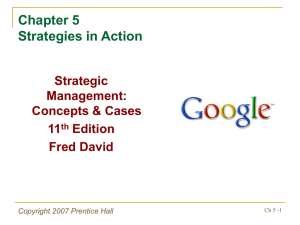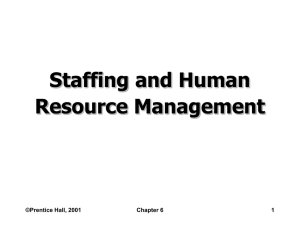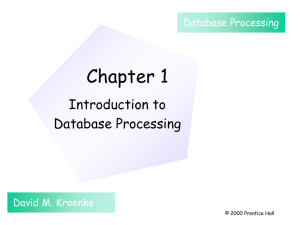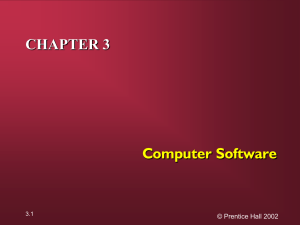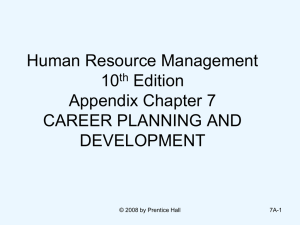Evaluation and Control
advertisement
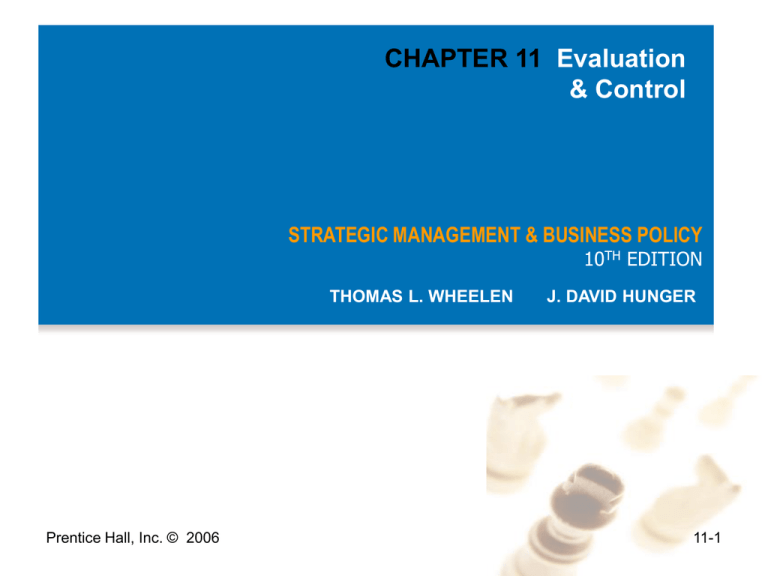
CHAPTER 11 Evaluation & Control STRATEGIC MANAGEMENT & BUSINESS POLICY 10TH EDITION THOMAS L. WHEELEN Prentice Hall, Inc. © 2006 J. DAVID HUNGER 11-1 Evaluation and Control Evaluation and Control Process Prentice Hall, Inc. © 2006 11-2 Evaluation and Control Corrective Action Questions – Is the deviation a chance fluctuation? – Are the processes being carried out correctly? – Are the processes appropriate to achievement of the desired result? – Who is the best person to take action? Prentice Hall, Inc. © 2006 11-3 Strategic Audit Outline I. Current Situation Current Performance Mission-Objectives-Strategies-Policies II. Corporate Governance BOD and Management III. External Environment (O-T) Societal-Task IV. Internal Environment (S-W) Structure-Culture-Resources by Functional Area V. Analysis of Strategic Factors SWOT-Review of Mission/Objectives VI. Strategic Alternatives/Recommendations Corporate-Business-Functional VII. Implementation Programs-Cost-Priorities VIII. Evaluation and Controls Feedback-Standards-Measures Prentice Hall, Inc. © 2006 15-4 Evaluation and Control Prentice Hall, Inc. © 2006 11-5 Evaluation and Control Evaluating an Implementation Strategy Problem areas/Corrections •Formulation •Assumptions •Scenarios •Situation or Trend •Execution •Communications •Management Commitment •Lack of Feedback •Functional Strategies •Consistent •Resource Allocation Prentice Hall, Inc. © 2006 11-6 Evaluation and Control Measuring performance – –The end result of activity Prentice Hall, Inc. © 2006 11-7 Evaluation and Control Types of Controls – –Behavior controls •How something is done through policies, procedures, rules, SOP’s –Output controls •What is to be accomplished; focus on end result through performance targets –Input controls •Resources – skills, abilities, values, motives Prentice Hall, Inc. © 2006 11-8 Evaluation and Control Types of Controls – –Behavior controls •ISO 9000 Standards Series - Quality •ISO 14000 Standards Series - Environment Prentice Hall, Inc. © 2006 11-9 Evaluation and Control Types of Controls – –Output Control •Activity Based Costing (ABC) •Allocation of indirect and fixed costs to individual products or product lines based on value-added activities •Focus on overhead/fixed cost rather than labor Prentice Hall, Inc. © 2006 11-10 Evaluation and Control Types of Controls – –Input Control •Enterprise Risk Management (ERM) •Identify risks •Rank risks •Measure risks Prentice Hall, Inc. © 2006 11-11 Evaluation and Control Primary Measures of Performance – –Traditional Financial Measures •Return on investment (ROI) =Net Income before tax/Total Assets •Earnings per share (EPS) =Net Income/Number of shares outstanding •Return on equity (ROE) = Net Income/Total Equity •Operating cash flow Takes into account cash generated by the company before financing and taxes. More accurate than EBITDA as it takes into account changes in working capital. Prentice Hall, Inc. © 2006 11-12 Evaluation and Control Primary Measures of Performance – –Stakeholder Measure Stakeholder Near Term Long Term Customer Sales Growth in Sales Supplier Cost Growth of Cost Financial Comm. EPS Growth of ROE Employees Productivity Turnover Congress Access to Key Members # New regulations Consumer Advocates # Meetings Changes in policy Environmentalists # Meetings Changes in policy Prentice Hall, Inc. © 2006 11-13 Evaluation and Control Primary Measures of Performance – –Shareholder Measures •Shareholder value – present value of anticipated future steams of cash flows from the business plus the liquidated value of the company Prentice Hall, Inc. © 2006 11-14 Evaluation and Control Primary Measures of Performance – –Shareholder •Economic value added (EVA) =after-tax operating income – (investments in assets * weighted cost of capital) •A positive EVA = Generating Economic Value •EVA improves by •Earning more profit w/o using more capital •Using less capital •Investing in high return projects Prentice Hall, Inc. © 2006 11-15 Evaluation and Control Primary Measures of Performance – –Shareholder •Market value added (MVA) =(Market Capitalization + Debt) – Invested Capital •MVA greater than zero means that the strategy is creating value. Prentice Hall, Inc. © 2006 11-16 Evaluation and Control Primary Measures of Performance – (Key Performance Factors or Critical Success Factors) –Balanced Scorecard Approach •Financial •Customer •Internal business perspective •Innovation and learning Unique to a company based on their strategy Prentice Hall, Inc. © 2006 11-17 Evaluation and Control Evaluating Top Management & Board – –Chairman-CEO Feedback Instrument –Company Performance –Leadership of the organization –Team building and management succession –Leadership of external constituencies –Management Audit – Activity or Function –Strategic Audit – SWOT review Prentice Hall, Inc. © 2006 11-18 Evaluation and Control Divisional & Functional Performance – –Responsibility Centers •Standard cost centers - manufacturing •Revenue centers - sales •Expense centers – Indirect cost/budget based •Profit centers – (Revenue – Expenses) based on Transfer Pricing •Investment centers – ROI measures Prentice Hall, Inc. © 2006 11-19 Evaluation and Control Using Benchmarking – –Continual process of measuring products, service, and practices against the toughest competitors or those companies recognized as industry leaders –American Productivity & Quality Center Prentice Hall, Inc. © 2006 11-20 Evaluation and Control International Measurement Issues – –Currency Exchange Rates –Inflation –Tax Laws –International transfer pricing –Repatriation of profit –Piracy Prentice Hall, Inc. © 2006 11-21 Evaluation and Control Strategic Information Systems – –Enterprise Resource Planning (ERP) –Divisional and functional IS support Prentice Hall, Inc. © 2006 11-22 Evaluation and Control Problems in Measuring Performance – “If you can't measure it you can’t control it.” (M Whitman) –Short-term orientation –Goal displacement •Behavior substitution What you reward is what you get. •Sub-optimization Unit goals override organization goals. Prentice Hall, Inc. © 2006 11-23 Evaluation and Control Guidelines for Proper Control – –Minimum amount of information necessary –Meaningful activities and results –Timely –Long and short-term –Pinpointing exceptions –Reward – Not Punishment Prentice Hall, Inc. © 2006 11-24 Evaluation and Control Strategic Incentive Management – –Weighted-factor method Factors are weighted based on the SBU environment –Long-term evaluation method Stock share price based on some index –Strategic funds method Remove R&D or Strategic investments from the financial performance Prentice Hall, Inc. © 2006 11-25 Evaluation and Control Strategic funds method Account Sales Amount $12,300,000 Cost of Sales -6,900,000 Gross Margin $5,400,000 G&A -3,700,000 ROS (Performance Measurement) Strategic Funds Pretax Profit Prentice Hall, Inc. © 2006 1,700,000 -1,000,000 700,000 11-26 CHAPTER 11 Evaluation & Control STRATEGIC MANAGEMENT & BUSINESS POLICY 10TH EDITION THOMAS L. WHEELEN Prentice Hall, Inc. © 2006 J. DAVID HUNGER 11-27

